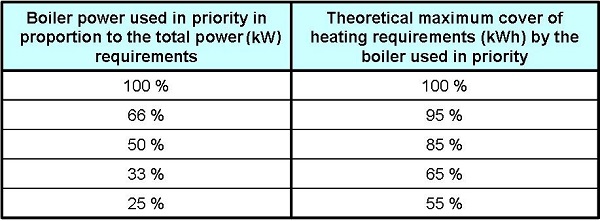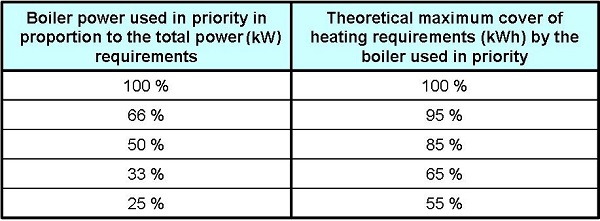If the heating system has 2 boilers, and the heating circuits are not all low temperature, it is of little use that the 2 boilers are changed to condensing boilers. A pairing of a condensing boiler and a standard or low temperature boiler would be a sufficient solution.
In fact, the 2 boilers are only required during extreme cold, a few days per year. Moreover, during these periods, return temperatures are high and condensing boiler efficiency low. The financial investment of a second condensing boiler is therefore difficult to recoup.
If the system has a condensing boiler and a standard or low temperature boiler, we would use, in priority, the condensing boiler which would cover most requirements.
In fact if the system has 2 boilers both with 50% of power needs ([kW]), the priority use of one boiler (condensing) permits 85% of heating requirements ([kWh]) to be covered (see table below).

Explanation:
let’s suppose we have a system equipped with 4 boilers, each
corresponding to 25% of power requirements. If we use one of these 4
in priority, it will cover much more than 25% of heat requirements
(55% according to the table above).
Let’s
study graphically the situation for 2 boilers. If we use one of these
2 in priority, it will cover much more than 50% of heat requirements:

If, as well, we consider the number of hours and the exterior temperature, the graph is even more telling:

In our moderated climates (France), the number of hours when the temperature is very low is minimal.
Question
In theory, how much of the total consumption can be covered by 1 of the 3 boilers if used in priority?
In a system of 750 [kW], one condensing boiler of 250 [kW] representing 33% of the required power, could cover 65% of requirements.
Question
In theory, how much of the total consumption can be covered by 2 of the 3 boilers if used in priority?
In a system of 750 [kW], 2 condensing boiler of 250 [kW] representing 66% of the required power, could cover 95% of requirements.


